|
|
 |
|
Calanoida ( Order ) |
|
|
|
Diaptomoidea ( Superfamily ) |
|
|
|
Centropagidae ( Family ) |
|
|
|
Sinocalanus ( Genus ) |
|
|
| |
Sinocalanus tenellus Kikuchi, 1928 (F,M) | |
| | | | | | | Syn.: | Limnocalanus sinensis var. tenellus : Kikuchi, 1928 (p.67, pl.XVIII, figs. 1-8) | | | | Ref.: | | | Kos, 1976 (Vol. II, figs.F, M, Rem.); 1984 (1985) (p.232, figs. F, M, Rem.) |  issued from : W. Zhang, N. Zhao, Z. Tao & C. Zhang in An Illustrated Guide to Marine Planktonic Copepods in China Seas, Science Press, Beijing. [p.457, Fig.516]. Female: a-b, habitus (dorsal and lateral, respectively); c, P5 ventral view). Male: d, habitus (dorsal); e, P5 (ventral view)
|
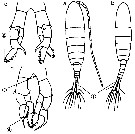 Issued from : M. Chihara & M. Murano in An Illustrated Guide to Marine Plankton in Japan, 1997. [p.774, Pl. 87, fig.121 a-d]. After Chen & Zhang, 1965. Female: a, habitus (dorsal); c, P5. Male: b, habitus (dorsal); d, P5. Nota: numbers show characteristics to compare with S. sinensis.
|
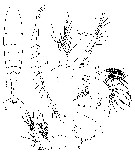 Issued from : M.S. Kos in Issled. Fauny Morei, 1984 (1985), 30 (38). [p.233, Fig.3]. Female (from South Sakhalin Islands): 1, habitus (dorsal); 2, A1; 3, A2: 4, Mx1; 5, Md (gnathobase and palp).
|
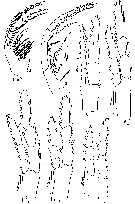 Issued from : M.S. Kos in Issled. Fauny Morei, 1984 (1985), 30 (38). [p.234, Fig.4]. Female (from South Sakhalin Islands): 1, Mx2; 2, Mxp; 3, P5; 4, P2; 5, P1; 6, P3; 7, P4.
|
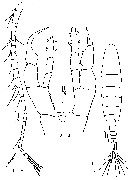 Issued from : M.S. Kos in Issled. Fauny Morei, 1984 (1985), 30 (38). [p.235, Fig.5]. Male (from South Sakhalin Islands): 1, habitus (dorsal); 2, A1; 3, P5
| | | | | Compl. Ref.: | | | Uye S-i., 1982 (p.149, relation length-weight-C-N); Kimoto & al., 1986 (p.43, Rem.: Growth); 1986 a (p.133, egg production); Hada, 1991 (p.43, Rem.: Cannibalism); Huntley & Lopez, 1992 (p.201, Table 1, A1 eggs, egg-adult weight, temperature-dependent production); Uye & Kaname, 1994 (p.43, length vs. fecal pellet volume); Madhupratap & al., 1996 (p.77, Table 2: resting eggs); Uye & al., 2000 (p.193, fig.7 : abundance vs t°, Sal.); Peterson W.T., 2001 (p.91, stage duration & development); Soh & al., 2008 (Table 4); Ohtsuka & al., 2008 (p.115, Table 5); Sakaguchi & al., 2011 (p.18, Table 1, 2, occurrences); Youn & al., 2012 (p.33, Table 1, 2: seasonal composition); Barton & al., 2013 (p.522, Table 1: metabolism, diapause, biogeo); Suzuki, K.W. & al., 2013 (p.15, Table 2, 3, 4, fig.6, estuaries, annual occurrence); Park E.-O. & al., 2013 (p.165, Fig.5, distribution vs stations); Ohtsuka & Nishida, 2017 (p.565, 578, 579, Table 22.1); | | | | NZ: | 3 | | |
|
Distribution map of Sinocalanus tenellus by geographical zones
|
| | | | | | 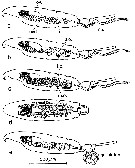 Issued from : K. Kimoto, S.-i. Uye & T. Onbé in Bull. Plankton Soc. Jpn, 1996, 33 (2). [p.136, Fig.1]. Issued from : K. Kimoto, S.-i. Uye & T. Onbé in Bull. Plankton Soc. Jpn, 1996, 33 (2). [p.136, Fig.1].
Schematic illustration of the oogenesis of Sinocalanus tenellus from brackish-water pond in Fukuyama and laboratory-reared between January and March 1983.
a, with ''immature'' oocytes in the oviducts; b, with ''developing'' oocytes in the oviducts; c, with ''mature'' oocytes in the oviducts; d, dorsal view of c; e, during spawning.
ov.: ovary; ovd. oviducts; sp.: spermatophore; i.o.: ''immature'' oocyte; d.o.: ''developing'' oocyte; m.o.: ''mature'' oocyte.
Nota: One female was capable of producing more than 2531 eggs during 70 days after molting to adult. At high food concentrations, the egg production rate became maximal around 20°C at 60 eggs/female/day or 0.37 by day in terms of carbon weight-specific rate. |
 Issued from : K. Kimoto, S.-i. Uye & T. Onbé in Bull. Plankton Soc. Jpn, 1996, 33 (2). [p.138, Fig.4]. Issued from : K. Kimoto, S.-i. Uye & T. Onbé in Bull. Plankton Soc. Jpn, 1996, 33 (2). [p.138, Fig.4].
Effect of food abundance on the daily egg production of Sinocalanus tenellus laboratory-reared at 20.5°C.
Vertical lines: ±S/D. The curve is eyefitted one.
Food: Isochrisis galbana (ca.5x10 power 4 cells per ml) and Thalassiosira weissflogii (ca. 5 x 10 power 3 cells per ml). |
 Issued from : K. Kimoto, S.-i. Uye & T. Onbé in Bull. Plankton Soc. Jpn, 1996, 33 (2). [p.139, Fig.6]. Issued from : K. Kimoto, S.-i. Uye & T. Onbé in Bull. Plankton Soc. Jpn, 1996, 33 (2). [p.139, Fig.6].
The daily egg production of Sinocalanus tenellus laboratory-reared at various temperatures with the maximum fecundity during the 22 days after the last molt. |
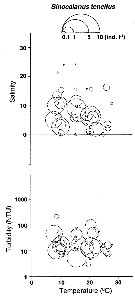 Issued from : K.W. Suzuki, K. Nakayama & M. Tanaka in J. Oceanogr., 2011, 69. [p.24, Fig.6]. Issued from : K.W. Suzuki, K. Nakayama & M. Tanaka in J. Oceanogr., 2011, 69. [p.24, Fig.6].
Bubble plots of densities of the non semi-endemic oligohaline calanoid Sinocalanus trnellus in relation to temperature, salinity, and turbidity observed in the Midori River estuary (south Japan) in 2005 and 2006. |
| | | | Loc: | | | China Seas (estuaries), SE Korea (Seomjin River estuary, Yongsan River estuary), Japan (Osaka: Kanzaki River, Inland Sea, Fukuyama pond, south estuaries: Chikugo, Midori & Kuma Rivers, Lake Nakaumi), right up to the north of Sakhalin | | | | N: | 16 | | | | Lg.: | | | (1054) F: 1,25-1,45; M: 1,30-1,40; (1232) F: 1,03-1,1; M: 1,03-1,11; {F: 1,03-1,45; M: 1,03-1,40} | | | | Rem.: | Brackish, estuaries. Mainly herbivorous, but also carnivorous.
Incomplete data.
Ohtsuka & Nishida point to in the Inlet and brackish waters on the main islands of Japan, this species is dominant. For these authors, in Lakes Nakaumi and Shinjiko, yhis species aggregates just above the pycnocline (Harada & al., 1985. The mechanism by which positioning of planktonic copepods is maintened during flooding in estuaries was clarified by Ueda & al. (2004).
Thanks to Denis Zavarzin, p.h.d. (Laboratory of Hydrobiology SakhNIRO, Yuzhno-Sakhalinsk, Russia) for the occurrence of distribution of Sinocalanus tenellus in the north of Sakhalin. | | | Last update : 19/06/2023 | |
|
|
 Any use of this site for a publication will be mentioned with the following reference : Any use of this site for a publication will be mentioned with the following reference :
Razouls C., Desreumaux N., Kouwenberg J. and de Bovée F., 2005-2025. - Biodiversity of Marine Planktonic Copepods (morphology, geographical distribution and biological data). Sorbonne University, CNRS. Available at http://copepodes.obs-banyuls.fr/en [Accessed December 28, 2025] © copyright 2005-2025 Sorbonne University, CNRS
|
|
 |
 |











